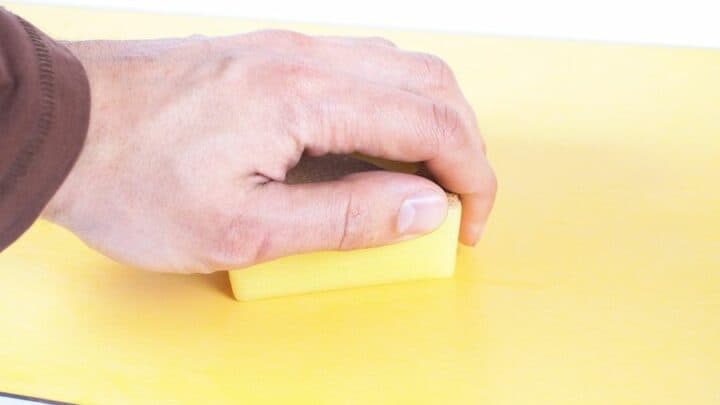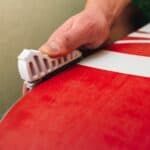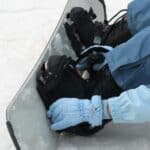If you enjoy snowboarding, you should know how to preserve and maintain your board. Waxing is an important step to protect your snowboard — while also helping optimize its performance on the slopes.
When boards are not waxed often enough, they dry out, crack, and become irreversibly damaged over time.
Table of Contents
How to Wax a Snowboard
Waxing a snowboard involves removing wax and cleaning the base of your board, and then adding more wax and scraping off the excess. Tools include iron to heat the wax, a metal or plastic scraper, and plenty of buffing cloths. It usually takes an hour but could be a bit longer depending on climate conditions.
Waxing a Snowboard
If you snowboard regularly, you probably know that it is recommended that you wax a snowboard approximately after every two to three days of use.
Some factors that can change this frequency include the type of board you own and the conditions that you will be snowboarding in, too.
There are typically two types of snowboard bases that also play a role in the frequency of waxing — sintered and extruded styles.
Sintered bases are more porous and should be waxed often to keep them fast and smooth on the slopes.
Extruded base snowboards require less frequent waxing but learn to spot the signs that your board — whether sintered or extruded base — needs some wax. When snowboards seem to slow down during use, it is usually time to wax.
How to Wax a Snowboard
Waxing a snowboard can be a very relaxing and enjoyable experience — especially when you consider how it improves the board’s performance on the slopes!
A freshly waxed board is usually faster and glides smoother across the snow.
When you are ready to wax your board, follow the steps below:
First, clean the board’s base
Get rid of any old wax remaining on your snowboard using a plastic or metal scraper. Work front to back, or tip to tail.
Is your snowboard especially dry? You might be able to skip the scraping part, but make sure to clean the base well.
Warm your wax
Decide on a wax — light or dark — and warm up the iron to melt it with. Do not try to wax your snowboard when the board itself is cold as the wax won’t absorb properly.
Make sure that the snowboard is at room temperature before you begin.
Drip wax onto the board
Melt the wax by gently contacting the iron, which should be tilted so that the wax drips directly down to the base of your board.
Focus the wax about an inch from the edges, and then drip drops on the overall base a couple of inches apart.
Move your iron
Now, move the iron evenly over the snowboard base in a circular motion.
Don’t stay in one spot too long — keep moving your iron so that you don’t damage or burn your board.
Wait a minute
Actually, wait about ten minutes for your snowboard to cool down after ironing the wax on it.
Scrape the base again
Is the board completely dry?
If it is, scrape it again, front to back to remove the wax that has not been absorbed in the pores of the board.
Buff to remove any excess
Finally, buff the board to spread any remaining wax until smooth!
Don’t forget to buff around the edges of the base, too.
Frequently Asked Questions about How to Wax a Snowboard
What do you need to wax a snowboard?
Some things that you need to wax a snowboard include wax, a waxing iron, a metal or plastic scraper, buffing pads, and a general base cleaning solution. A pair of vice grips is also helpful when holding the board in place during the scraping process.
How do you know if a snowboard needs waxing?
If you see white spots on the bottom or base of your snowboard, it needs waxing. Experts suggest that you wax your snowboard every couple of times that it is used.
How long does waxing a snowboard take?
It takes around an hour to wax your snowboard, perhaps a bit longer depending on drying time in your climate.
Can you wax a snowboard too frequently?
You can’t wax a snowboard too often. While not waxing enough can cause irreversible damage to the board, too much wax does not.
What wax should you use for snowboards?
Wax is offered in different colors reflective of different compounds made for distinct conditions. During warmer-weather snowboarding, wax with bright colored wax, such as yellow or pink. During cold weather conditions, use dark wax, like green or blue.
Should you wax a brand-new snowboard?
Wax a new snowboard as they are usually factory-waxed but only minimally. You cannot over-wax a snowboard.
How do you tune up a snowboard?
Tuning up a snowboard involves filing and sharpening the edges of the board. If you are not experienced, you may want to take your board to a snowboarding shop for a professional tune-up.
How frequent should you tune up a snowboard?
The frequency of tune-ups depends on how much you use the snowboard. For regular, frequent snowboarders, you may want to tune up every week. For those that don’t snowboard often, tune up once when the snow season is over.
Conclusion
Waxing a snowboard helps to preserve and protect your investment.
Since you can’t over-wax your board, err on the side of caution and wax frequently for longevity and optimal performance.




